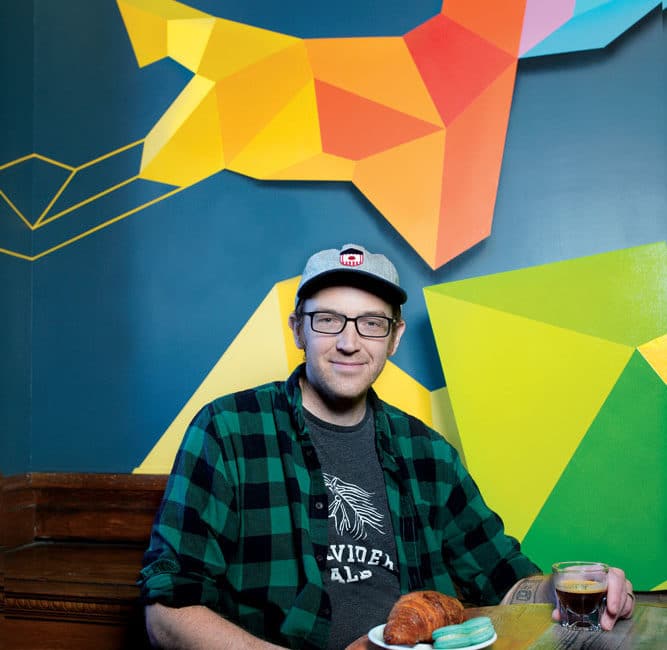
March Foodie Extra: Neal Warner’s Tips On Perfect At-Home Coffee
Neal Warner has been wooing even the snobbiest of coffee snobs since opening Coat Check Coffee (401 E. Michigan St., 317-550-5008) in February of 2017. On the cusp of opening Provider, his newest coffee bar and restaurant inside The Tinker House (1101 E. 16th St.), he tells us how to brew the perfect cup of coffee at home. (Spoiler alert: no pour over pressure here. There’s an easier way.)
THE BASICS: COFFEE BEANS AND EQUIPMENT
Fresh Is Best
Ideally, purchase coffee within two weeks of its roast date, and only purchase as much as you’ll use in two to three weeks after that (avoid bags that don’t display the roast date). Cafes and roasters are often the best places to find fresh coffee. Store your beans at room temperature, tightly sealed and away from light. Medium-to-light roasts reveal the nuance of a coffee’s origin and processing, which is desirable if you’re going to invest the money in a high quality product.
Grind Your Own Beans
It is best to grind coffee shortly before its brewed, since ground coffee gets stale much faster than whole beans. However, I would opt for having my coffee ground at a cafe rather than using a blade-style spice grinder. For better results at home, consider a burr grinder like the Capresso 560. It’s quieter and more affordable than some of its competitors. The Baratza line is also nice and frequently recommended. For hand grinders, I recommend a Handground.
Save The Pour Overs For Coffee Shops
I tend to steer people toward good quality automatic drip coffee machines at home, rather than pour over setups that require a kettle and dripper. While pour overs can create excellent cups, they take more time and often result with gear stuffed in a cupboard in favor of K-cups. Automatic drip coffee makers also allow you to make more coffee at once, a nice option when hosting guests. For the value, the Bonavita line of home coffee makers is hard to beat. For the premium option, Technivorm brewers offer excellent temperature stability and durability. If you travel a lot or typically make just a single serving in the mornings, I recommend the Aeropress. It’s small and durable, doesn’t require a special kettle, and takes less time than a pour over.
HOW TO MAKE GOOD COFFEE AT HOME
Keep Your Equipment Clean
Discard the spent grounds right after brewing, and immediately rinse the basket. Handwash the basket every few days, using a scouring pad to get into the little grooves. Clean the carafe regularly.
Pick The Right Filters
Use clean, bright white filters, and store them separately from spices and other products that smell in the cabinet. It sounds counterintuitive, but the “natural” brown, unbleached filters leave a much stronger paper taste in the brew. If you do use them, place them in the basket and rinse thoroughly before adding your coffee.
Water Matters
Indianapolis water is hard and contains chloramine, a common disinfectant. It’s doesn’t taste great, which means it won’t brew a great cup of coffee. Since the coffee you’re drinking is about 98.65% water, you need to start with good water. I recommend treating your water at home, or getting it elsewhere. An easy option is to add spring water to your weekly grocery list. Look for clear plastic one-gallon jugs instead of opaque (which can leave a residual plastic taste). Avoid distilled water, because minerals in the water are important for taste, and they help pull the good stuff out of the coffee. Another home option is to pour your tap water through a carbon filter several times before you brew your coffee. The water will still be hard, but most of the chloramine and taste of lake water will be gone.
Use A Scale
If you don’t have a digital kitchen scale, its time to get one. A typical drip coffee recipe is one part coffee to sixteen parts brewing water by weight. The grounds will retain some water upon completion, so the resulting brew will yield a little less liquid than you started with.
Now, Make Your Coffee:
- Using your digital scale, measure 65g of coffee.
- Grind it until it resembles coarse sea salt.
- Put it into the filter, and shake the coffee bed so it’s level.
- Use your digital scale to weigh 1000g of water into the carafe that came with your automatic drop coffee maker.
- Pour the water into the coffee maker and turn it on.
- If the taste of the finished brew isn’t exactly what you hoped for, you can adjust the setting on your grinder until you get the most balanced cup. If your coffee is too bitter, make the grind courser. If it’s weak and/or sour, make the grind finer. The perfect grind setting will change with each coffee and batch size, and as the coffee ages.





